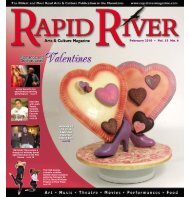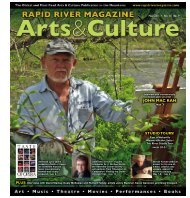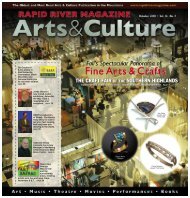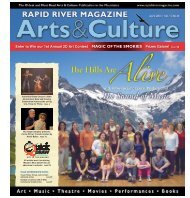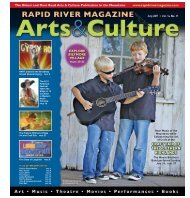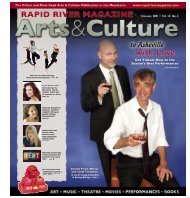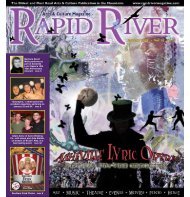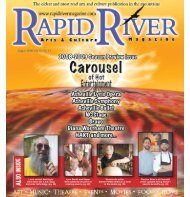Rapid River Magazine, october 2006
Rapid River Magazine, october 2006
Rapid River Magazine, october 2006
Create successful ePaper yourself
Turn your PDF publications into a flip-book with our unique Google optimized e-Paper software.
R A P I D R I V E R A R T S & C U L T U R E M A G A Z I N E<br />
ARTNOTES<br />
O C T O B E R A R T N E W S B y J e f f D a v i s<br />
Frank Harmon: Modernism<br />
meets the farm house<br />
Architecture is the triumph of human imagination<br />
over materials, methods, and men, to<br />
put man into possession of his own earth.<br />
A<br />
—Frank Lloyd Wright, 1930.<br />
rchitecture is certainly the most<br />
unforgiving of the arts.<br />
A painting which we’ve grown<br />
tired of can be sold or put away<br />
until it pleasures our eyes again;<br />
a dance persists but for the moment of its<br />
actual movement, and there’s no way to<br />
revisit the actual event, whatever media<br />
we might have brought to bear on it. Good<br />
or ill, it’s gone, ephemeral as dawn. But<br />
the artworks of the architect are the very<br />
spaces in which we live, labor and play. If<br />
they’re unlivable, well … As Frank Lloyd<br />
Wright said, “The physician can bury<br />
his mistakes, but the architect can only<br />
advise his clients to plant vines.” (New<br />
York Times <strong>Magazine</strong>, 4 Oct. 1953) Vines,<br />
unfortunately, won’t do much for poorly<br />
designed interior space. There, the remedies<br />
are more radical – and far more dear.<br />
True confession: way back in the<br />
1960s, when I was a teenager trying to<br />
decide what to do with my life, I seriously<br />
considered becoming an architect. It seems<br />
like a curious consideration, looking back;<br />
there were no buildings in Charlotte that I<br />
knew of that excited me with their redefinition<br />
of structural dynamics.<br />
I had encountered, though, the work of<br />
Frank Lloyd Wright through his writings<br />
on the “natural house” and through photographs<br />
of his structures in the books I<br />
sought out about the man.<br />
I think I recognized in him, however<br />
little I knew about the field in which he<br />
worked, a great auteur, a creative original.<br />
Part of my psyche has been fascinated by<br />
architecture ever since. When I went to<br />
Buffalo, New York, in 1968, one of the<br />
city’s several attractions was that it was<br />
home to Black Mountain College poet<br />
Robert Creeley, but another was the location<br />
of several of Wright’s prairie-phase<br />
homes. The State University of New York,<br />
in fact, had just the year before acquired<br />
the Darwin D. Martin House Complex,<br />
built between<br />
1903 and 1905;<br />
the University<br />
used it as its<br />
president’s<br />
residence. The<br />
president often<br />
opened it for<br />
receptions and<br />
parties, so several<br />
times I had the<br />
pleasure of visiting<br />
and exploring,<br />
between<br />
glasses of wine<br />
and conversations<br />
about the<br />
topics of the day,<br />
that magnificent<br />
old building,<br />
which still contained,<br />
if memory<br />
serves, some<br />
Frank Harmon<br />
pieces of the original furniture that Wright<br />
had designed for it.<br />
That active interest in architecture<br />
has been dormant for some years now, as<br />
creative energies found other channels,<br />
but the new Thinking Ahead exhibit at the<br />
Black Mountain College Museum + Arts<br />
Center has certainly stirred it up again.<br />
The show offers tantalizing glimpses of the<br />
work of a few of the modernist architects<br />
associated with the college who worked<br />
in the same era as Wright to reshape our<br />
experience of lived space, and create a<br />
new architecture, one freed from classical<br />
traditions. On Oct. 26, Raleigh architect<br />
Frank Harmon, FAIA, whose firm was<br />
selected by Residential Architect <strong>Magazine</strong><br />
as the 2005-<strong>2006</strong> Residential Architect<br />
Firm of the Year, journeys to Asheville to<br />
speak on the subsequent development of<br />
Modernism in our own era, in the south<br />
of farmhouses and traditional vernacular<br />
structures. It’s a subject he should know<br />
well, since his own work clearly takes the<br />
Modernist project as its initial premise.<br />
Given that Harmon’s firm has been<br />
selected to develop the new UNCA Crafts<br />
Campus north of town along the French<br />
Broad <strong>River</strong>, his presentation should spark<br />
significant interest in our fair mountain<br />
city<br />
İ’ve not yet set foot in a<br />
Harmon building, but his firm’s<br />
website offers an extensive collection<br />
of photographs of his<br />
projects through the years, both<br />
small projects (there’s even a<br />
dog house, or dog box, as the site<br />
qualifies it) and large – as in the<br />
very attractive 70,000 square foot<br />
renovation and addition to the NC<br />
Farm Bureau in Raleigh. It’s an<br />
impressive body of work, a unique<br />
blend of Modernist aesthetic and<br />
vernacular values. It manifests<br />
decent respect, even affection, for<br />
the materials of structure (especially<br />
wood, often exposed to<br />
great effect). The Farm Bureau<br />
project, with its emphasis on open<br />
space and its artful use of interior<br />
columns, reminded me (given<br />
that Frank Lloyd Wright’s work is<br />
still an important point of reference for<br />
me), for all the apparent difference of<br />
scale, of Wright’s office projects, such<br />
as the Johnson Wax building in Racine,<br />
Wisconsin, with its graceful columns and<br />
cantilevered ceiling.<br />
He seems to be able to make even compact<br />
buildings feel open and expansive,<br />
and yet his work (as revealed at least in the<br />
photographs) can convey also a sense of<br />
shelter, something sometimes hard to come<br />
by in a typical Modernist structure. It’s<br />
that rare combination of qualities, the tension<br />
between the vernacular and modern,<br />
that led a juror in the AIA North Carolina<br />
competition in 1999 (when Harmon won<br />
three out of the four Honor awards for<br />
which he was entered) to remark, “I don’t<br />
who this guy is, but he’s either a genius or<br />
a schizophrenic.”<br />
In an interview for a recent article in<br />
Residential Architect, Harmon attributes<br />
his approach to his mentor of many years,<br />
Harwell Harris. “What people thought was<br />
cold and threatening modernism, he made<br />
warm and approachable,” Harmon says.<br />
“Harwell was a big influence on me in this<br />
way: he taught me that every client and<br />
every situation is different and new. And<br />
it is the architect’s job to understand the<br />
needs of every situation and every client.<br />
He loved to say that the house is a portrait<br />
of the client. He was a very important person<br />
to me – still is.”<br />
Harmon seems to have mastered that<br />
art of portraiture, and to be able, as Wright<br />
had it, to put his clients in possession of<br />
their own earths.<br />
It should be an enlightening evening.<br />
If you go:<br />
What: Frank Harmon, The<br />
Bauhaus + The Farmhouse:<br />
Reflections on the Modern<br />
Movement in the South.<br />
There will be a reception<br />
and silent auction to benefit<br />
BMCM+AC. Co-sponsored<br />
by AIA Asheville and the<br />
UNCA Office of Cultural and<br />
Special Events.<br />
When: Thursday, Oct. 26,<br />
7:30pm<br />
Where: Broadway Arts Building,<br />
49 Broadway, downtown<br />
Asheville.<br />
Admission: $12 or $6/students.<br />
Free parking for the<br />
event at Home Trust Bank.<br />
Poet and computor consultant<br />
Jeff Davis is a board member of the<br />
Black Mountain College Museum<br />
+ Arts Center. E-mail Davis at<br />
jeffbdavis@gmail.com. For more info<br />
visitnaturespoetry.blogspot.com<br />
‘CD’s’ continued.<br />
listens, reveling in the enjoyment and rediscovery<br />
of her vision. *****<br />
Dan Bern<br />
'Breathe'<br />
Messenger Music<br />
It’s not in Dan Bern to craft an album<br />
that feels undeveloped and truly misguided,<br />
but Breathe never coalesces in<br />
quite the same manner as such recent<br />
gems as Fleeting Days and New American<br />
Language.<br />
Though the outing begins and ends in<br />
a promising fashion, its middle section not<br />
only suffers from a lack of insistence, but<br />
also loses sight of its’ own presumed narrative<br />
thread. Too much of the album sounds<br />
sloppy and half baked, as if Bern and producer<br />
Ryan Freeland never quite came to<br />
terms of agreement.<br />
“Tongue-Tied” finds Bern woefully<br />
lifting from John Lennon while the Elvis<br />
Costello like “Rain” is little more than<br />
infectious filler. Throughout his career<br />
Bern’s songwriting has occasionally<br />
sounded derivative, and while he has<br />
shown himself capable of building sturdy<br />
melodic refrains, they frequently do little<br />
to counter his reputation as “the latest new<br />
Bob Dylan.”<br />
Typically, though, he’s turned his deficiencies<br />
into strengths, carefully dismantling<br />
the arrangements of his influences’<br />
material and using the parts to support his<br />
own sharply worded, stream of consciousness<br />
lyrics. Not surprisingly, all four of<br />
this efforts highlights-the title track and the<br />
killer trio of "Trudy," "Past Belief," and the<br />
marvelously convoluted “Feel Like a Man,"<br />
—serve as prime examples of his capacity<br />
as a songwriter.<br />
On each he effectively skewers the corrosive<br />
nature of western society’s materialistic<br />
culture, even as he searches for something<br />
that is more meaningful to satisfy the<br />
emptiness in our souls.<br />
If the rest of Breathe were as poignant<br />
and focused, it might have stood as Bern’s<br />
finest effort to date. Instead, its inconsistency<br />
considerably tempers the forward<br />
momentum of his past few albums, making<br />
it a frustratingly uneven excursion that vacillates<br />
between being wholly essential and<br />
pleasantly irrelevant. **1/2<br />
Vol. 10, No. 2 — <strong>Rapid</strong> <strong>River</strong> ArtS & CULTURE <strong>Magazine</strong>— October <strong>2006</strong> 15




